ASHTON AND NEARBY AREAS
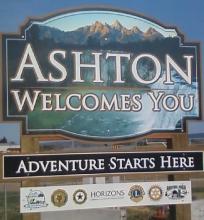 Ashton, Idaho is located in some of the most scenic areas in the northwest. Situated in the north eastern area of the state, Ashton is in close proximity to the Teton Valley of Idaho, West Yellowstone, Montana and the southern border of Yellowstone National Park. Known world wide as the largest seed potato producing area, Ashton is also known for the great recreational opportunities that can be found in and around the area.
Ashton, Idaho is located in some of the most scenic areas in the northwest. Situated in the north eastern area of the state, Ashton is in close proximity to the Teton Valley of Idaho, West Yellowstone, Montana and the southern border of Yellowstone National Park. Known world wide as the largest seed potato producing area, Ashton is also known for the great recreational opportunities that can be found in and around the area.
The area is known for the hunting opportunities in the fall and the fantastic fishing in the summer. Located near the Henry’s Fork of the Snake River, the opportunities for both wonderful fishing and other water recreation is great. Simply floating down the river and enjoying the wildlife that graze along the riverbanks can be awe inspiring.
If flying over the snow-covered fields in the middle of the winter and enjoying the crisp mountain air is more to your liking, then travel to Ashton in the winter and enjoy the fantastic snowmobiling available in the area.
Just pick a season or pick an activity, then load up your car and head to Ashton, Idaho.
Upper and Lower Mesa Falls (approx 15mins away)
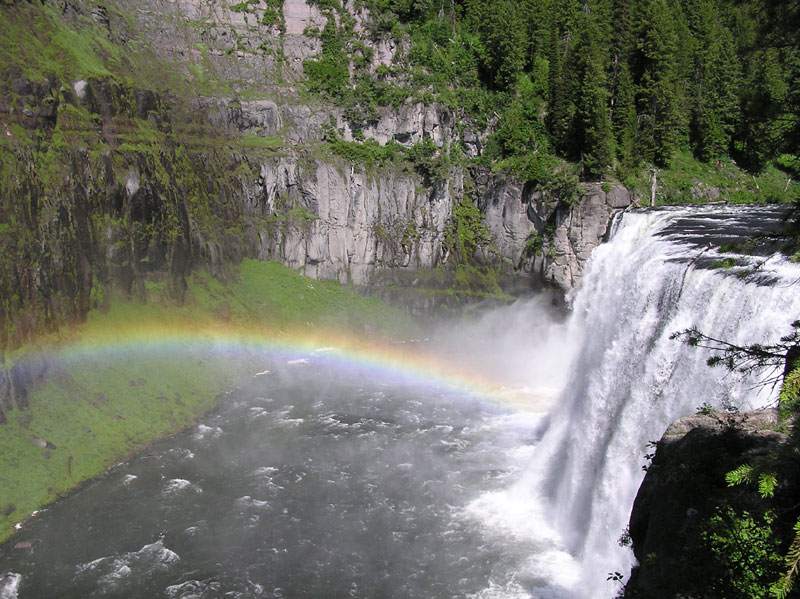 Visitors enjoy scenic waterfalls (some of the largest), wildlife sightseeing. Upper Mesa Falls is a waterfall on the Henrys Fork in the Caribou-Targhee National Forest. Upstream from Lower Mesa Falls, it is roughly 16 miles away from Ashton, Idaho. Upper Mesa Falls is roughly 114 feet high and 200 feet wide.
Visitors enjoy scenic waterfalls (some of the largest), wildlife sightseeing. Upper Mesa Falls is a waterfall on the Henrys Fork in the Caribou-Targhee National Forest. Upstream from Lower Mesa Falls, it is roughly 16 miles away from Ashton, Idaho. Upper Mesa Falls is roughly 114 feet high and 200 feet wide.
Lower Mesa Falls is a 65-foot waterfall on the Henrys Fork in Fremont County, Idaho. It is located in the Caribou-Targhee National Forest on the Mesa Falls Scenic Byway. It is downstream of Upper Mesa Falls.
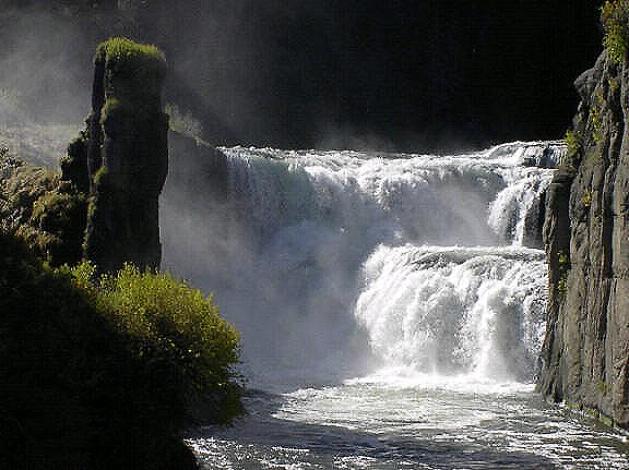 Not far off Highway 47 beyond Ashton in the Targhee National Forest, on the Mesa Falls Scenic Byway, you can hear the thunder of both Upper and Lower Mesa Falls. Two spectacular waterfalls on the Henrys Fork of the Snake River. Paved parking and paths, accessible restrooms, boardwalks and viewing platforms at Upper Mesa Falls enhance the site for the visitor. Viewing of Lower Mesa Falls is from Grandview Campground and Overlook. In winter the road is closed by snow and groomed for snowmobiling and Nordic skiing. Mesa Falls day pass can also be used at Harriman State Park and Henry’s Lake State Park on the day of purchase.
Not far off Highway 47 beyond Ashton in the Targhee National Forest, on the Mesa Falls Scenic Byway, you can hear the thunder of both Upper and Lower Mesa Falls. Two spectacular waterfalls on the Henrys Fork of the Snake River. Paved parking and paths, accessible restrooms, boardwalks and viewing platforms at Upper Mesa Falls enhance the site for the visitor. Viewing of Lower Mesa Falls is from Grandview Campground and Overlook. In winter the road is closed by snow and groomed for snowmobiling and Nordic skiing. Mesa Falls day pass can also be used at Harriman State Park and Henry’s Lake State Park on the day of purchase.
Visitors enjoy scenic waterfalls (some of the largest), wildlife sightseeing. Click here to read more about Mesa Falls
Kids and Adults Both Love To Feed Huge Trout
Feeding the fish at Warm River: (approx 10mins away) kids and adults both love seeing giant fish eating bread.
Harriman State Park (approx 15mins away)
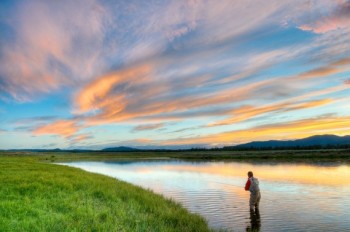 Offers visitors an opportunity to test their skills with world class fly fishing, horseback riding, pet zoo for the kids, hiking, sightseeing. A great place to take the family for a long or short walk by the river.
Offers visitors an opportunity to test their skills with world class fly fishing, horseback riding, pet zoo for the kids, hiking, sightseeing. A great place to take the family for a long or short walk by the river.
Harriman State Park lies within an 11,000-acre wildlife refuge in the greater Yellowstone Ecosystem. Moose, Elk, and Sandhill Cranes are common, as is North America’s largest waterfowl, the Trumpeter Swan. Known as one of the best fly-fishing streams in the nation, the Henrys Fork meanders for eight miles through Harriman. Over 20 miles of trails are available for hiking, biking, horseback riding, and cross county skiing. Guided horseback tours are offered by a park vendor.
Harriman State Park is located on the Henrys Fork of the Snake River. The park was once the site of the “Railroad Ranch” notable, due to its previous owners the Harriman’s of Union Pacific Railroad fame. Most of the original buildings have been preserved as part of the state park. The park has numerous hiking, biking and horseback trails and is known for its plentiful wildlife. The “Ranch” section of the Henrys Fork attracts fly fisherman from around the world seeking trophy trout.
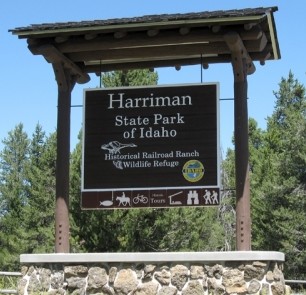 Not far off Highway 47 beyond Ashton in the Targhee National Forest, on the Mesa Falls Scenic Byway, you can hear the thunder of both Upper and Lower Mesa Falls. Two spectacular waterfalls on the Henrys Fork of the Snake River. Paved parking and paths, accessible restrooms, boardwalks and viewing platforms at Upper Mesa Falls enhance the site for the visitor. Viewing of Lower Mesa Falls is from Grandview Campground and Overlook. In winter the road is closed by snow and groomed for snowmobiling and Nordic skiing. Mesa Falls day pass can also be used at Harriman State Park and Henry’s Lake State Park on the day of purchase.
Not far off Highway 47 beyond Ashton in the Targhee National Forest, on the Mesa Falls Scenic Byway, you can hear the thunder of both Upper and Lower Mesa Falls. Two spectacular waterfalls on the Henrys Fork of the Snake River. Paved parking and paths, accessible restrooms, boardwalks and viewing platforms at Upper Mesa Falls enhance the site for the visitor. Viewing of Lower Mesa Falls is from Grandview Campground and Overlook. In winter the road is closed by snow and groomed for snowmobiling and Nordic skiing. Mesa Falls day pass can also be used at Harriman State Park and Henry’s Lake State Park on the day of purchase.
Offers visitors an opportunity to test their skills with world class fly fishing, horseback riding, pet zoo for the kids, hiking, sightseeing. A great place to take the family for a long or short walk by the river. Click here to read more about Harriman Park
YELLOWSTONE BEAR WORLD (Approx 45mins away)
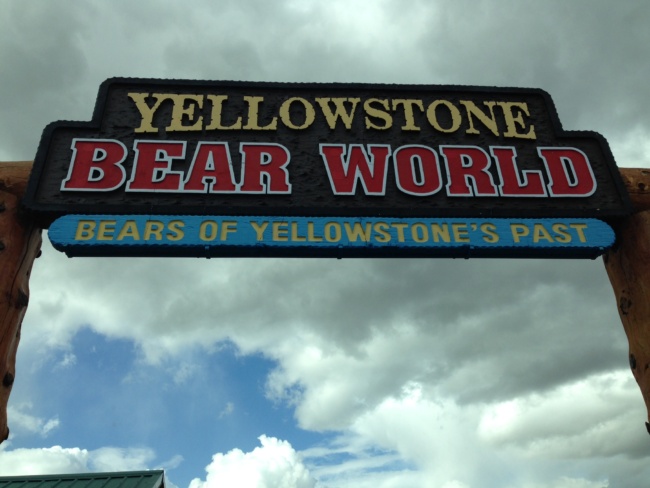 No vacation to the Yellowstone National Park or Grand Teton National Park region is complete without an adventure into the wild at Yellowstone Bear World, a drive-thru wildlife park. During your visit you will be surrounded by the free-roaming wildlife of North America as you drive your personal vehicle through the park. Wildlife you will see includes Rocky Mountain Elk, Bison, White-tail Deer, Mule Deer, Rocky Mountain Goats, Moose and of course American Black Bear, Grizzly Bear and Gray Wolves. Located 5 miles south of Rexburg, Idaho on US HWY 20 we are easily accessible from both Jackson Hole, Wyoming and West Yellowstone, Montana. When you visit this beautiful region don’t miss Idaho’s #1 wildlife attraction, Yellowstone Bear World.
No vacation to the Yellowstone National Park or Grand Teton National Park region is complete without an adventure into the wild at Yellowstone Bear World, a drive-thru wildlife park. During your visit you will be surrounded by the free-roaming wildlife of North America as you drive your personal vehicle through the park. Wildlife you will see includes Rocky Mountain Elk, Bison, White-tail Deer, Mule Deer, Rocky Mountain Goats, Moose and of course American Black Bear, Grizzly Bear and Gray Wolves. Located 5 miles south of Rexburg, Idaho on US HWY 20 we are easily accessible from both Jackson Hole, Wyoming and West Yellowstone, Montana. When you visit this beautiful region don’t miss Idaho’s #1 wildlife attraction, Yellowstone Bear World.
WYOMING – JACKSON HOLE (APPROX 1 HOUR AWAY)
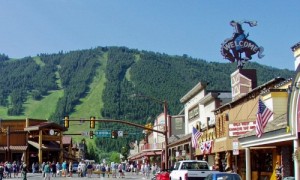 Jackson Hole is a thriving outdoor paradise during the summer months. As the Southern Gateway to both Grand Teton and Yellowstone National Park, many people base themselves in Jackson Hole and explore Teton hiking trails during the day. Take a scenic float through the park or enjoy whitewater rafting in the Snake River Canyon. Mountain biking trails leave right from town or you can enjoy a horseback riding excursion.
Jackson Hole is a thriving outdoor paradise during the summer months. As the Southern Gateway to both Grand Teton and Yellowstone National Park, many people base themselves in Jackson Hole and explore Teton hiking trails during the day. Take a scenic float through the park or enjoy whitewater rafting in the Snake River Canyon. Mountain biking trails leave right from town or you can enjoy a horseback riding excursion.
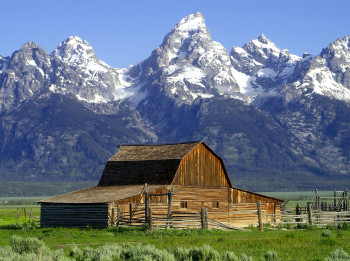 Wintertime in Jackson Hole, Wyoming offers a multitude of snow vacation activities for the whole family, from skiing and snowmobiling to dog sledding, sleigh rides and snow tubing.
Wintertime in Jackson Hole, Wyoming offers a multitude of snow vacation activities for the whole family, from skiing and snowmobiling to dog sledding, sleigh rides and snow tubing.
Jackson Hole is a winter sports lover’s paradise. You can take your pick from a wide array of activities, not limiting yourself to only the popular skiing and snowmobiling. But they are fun too!
Skiing: You’ll find incredible ski opportunities around Jackson Hole, with five nearby ski resorts.
Snowmobiling: As you explore Jackson Hole on a snowmobile, you will find yourself in a winter wonderland of wilderness.
Snowcoach Tours: Discover how pleasant it is, sitting in the warmth of a snowcoach, as you get a tour of the wildlife and landscapes of Jackson Hole, Wyoming and nearby national parks.
Dog Sledding: Take a short or long dog sled trip. You can even stay overnight on some.
Sleigh Rides: Immerse yourself in the beauty of Jackson Hole, moving silently across the snow, following beautiful alpine trails.
Snow Tubing: Snow tubing is a wintertime activity that doesn’t require any skill and yet provides fun for everyone.
Snowshoeing: Rent some snowshoes and start trekking through the wilderness areas and national forests around Jackson Hole.
YELLOWSTONE NATIONAL PARK (ID, WY, MT) (West Yellowstone Montana Entrance 15min away)
Yellowstone National Park. Yellowstone National Park is America’s first national park. n. the Northwest corner of Wyoming lies Yellowstone National Park, the oldest, largest and most popular National Park in the continental United States. Few places on earth offer so much scenic and scientific interest in one area. Yellowstone is in the heart of the Rockies, a land of pine-clad mountains and broad, grassy valleys. The countryside is laced with lakes and streams of exquisite beauty.
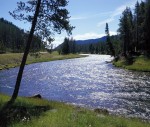
The popular West Entrance to Yellowstone parallels the winding Madison River, a route followed by the earliest pioneers into the park. It leads to the Grand Loop Road that will take you to all of the park’s major features.
In addition to superb mountain scenery, the park is one of the world’s principle wildlife preserves. Many visitors eagerly await the opportunity to photograph wildlife in its native environment. Yellowstone is a photographer’s paradise.
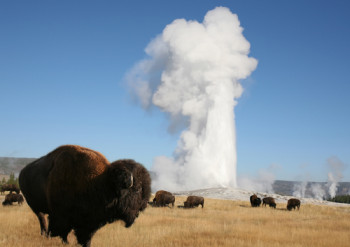
Traveling south on the Grand Loop Road towards Old Faithful, a side road leads to Firehole River Cascades. Here water pours through an 800 foot canyon, climaxing at roaring Firehole Falls.
The Firehole River is our introduction to the most famous and certainly the most popular section in all of Yellowstone. Our route takes us through a series of thermal basins, beginning with the Lower Geyser Basin. The road brings us close to the popular Fountain Paint Pot, pools of colorful, hot mud that bubble and sputter like pudding boiling in a pan. The mud is a mixture of silica, clay and water.
Bubbles are formed by super-heated gases rising from magma and molten rock deep within the earth. A stroll around Fountain Paint Pots revels a variety of small geyser, pools and springs.
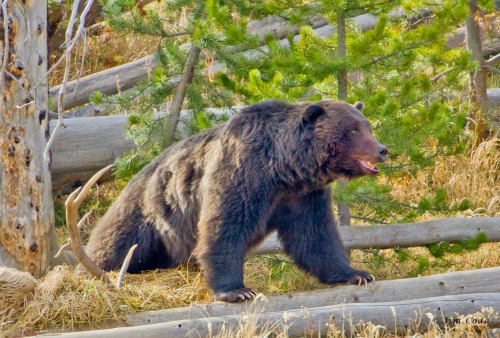
Midway, Biscuit and Black Sand basins lie adjacent to each other with the Firehole River serving as a common boundary. Runoff from many of the geysers in these basins drains into the nearby river. Each year Excelsior Geyser alone pours an incredible 5 million gallons of scalding water into the river.
At Midway Basin, Grand Prismatic Spring is the most spectacular feature. From above, its splendid array of deep colors is stunningly visible. At 370 feet in diameter, it is believed to be the largest spring in Yellowstone. Clearly marked boardwalks and paved trails offer visitors a safe and exciting means of exploring
In the Black Sand Geyser Basin, Cliff Geyser is interesting because it sits of the edge of Iron Spring Creek. Its eruptions can go as high as 50 feet.
Rainbow Pool is a large hot spring with an intensely blue center. The water at the pool’s edge is cooled sufficiently to permit the growth of algae, producing a rainbow of colors. Nearby Sunset lake vies with Rainbow Pool for beauty and iridescent color.

To many visitors, the Upper Basin, the Old Faithful area, is the heart and sole of Yellowstone Park. Unique Old Faithful Inn is one of America’s finest lodges. Today, its immense rustic lobby and huge stone fireplace yet posses the grandeur of earlier times.
No visit to Yellowstone is complete without witnessing one or more eruptions of Old Faithful Geyser. This iconic geyser is the most famous in the world and is one of America’s greatest natural wonders.There are geysers that erupt higher and for longer periods of time, but rarely is the tremendous power of nature so inseparably combined with Old Faithful’s innate beauty. This superb spectacle, once you’ve actually witnessed it in person, will stay in your memory forever.
Explore Yellowstone National Park
GRAND TETON NATIONAL PARK (APPROX 1 HOUR AWAY)
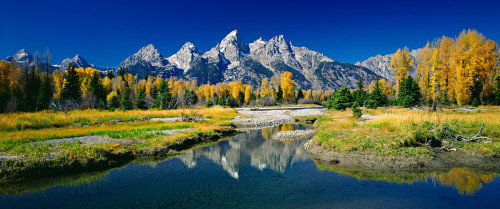 Rising above a scene rich with extraordinary wildlife, pristine lakes, and alpine terrain, the Teton Range stands monument to the people who fought to protect it. These are mountains of the imagination. Mountains that led to the creation of Grand Teton National Park where you can explore over two hundred miles of trails, float the Snake River or enjoy the serenity of this remarkable place.There are many outdoor recreation activities to choose from at Grand Teton National Park. During the summer you can hike, walk, view wildlife, take photographs, backpack, camp, climb, fish, swim, boat, float, canoe and bike. In winter skiing and snowshoeing are popular activities.
Rising above a scene rich with extraordinary wildlife, pristine lakes, and alpine terrain, the Teton Range stands monument to the people who fought to protect it. These are mountains of the imagination. Mountains that led to the creation of Grand Teton National Park where you can explore over two hundred miles of trails, float the Snake River or enjoy the serenity of this remarkable place.There are many outdoor recreation activities to choose from at Grand Teton National Park. During the summer you can hike, walk, view wildlife, take photographs, backpack, camp, climb, fish, swim, boat, float, canoe and bike. In winter skiing and snowshoeing are popular activities.
The Teton Range dominates Grand Teton National Park, attracting over 3 million people each year to gaze at their splendor.
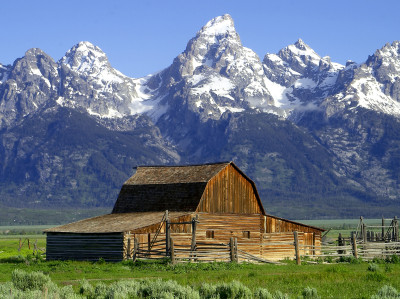
Snowcapped, snaggle-toothed peaks in Grand Teton National Park are the quintessential mountain range in America. The diversity in this valley with its abundance of wildlife, along with the historic geologic processes set Grand Teton National Park in a class of its own.
Quick Facts:
- Teton Range has more than twelve peaks at elevations greater than 12,000 feet.
- Its highest peak, the Grand Teton, reaches 13,770 feet.
- Seven moraine lakes run along the base of the range.
- More than 100 alpine lakes can be found in the backcountry.
- Over 200 miles of trails traverse through the mountainous terrain.
- 61 species of mammals and many species of birds call this park home.
